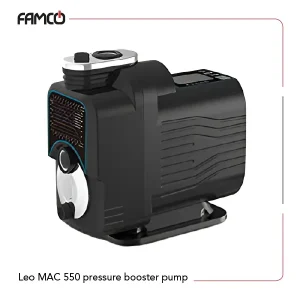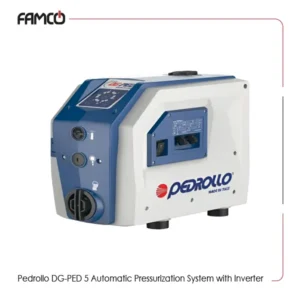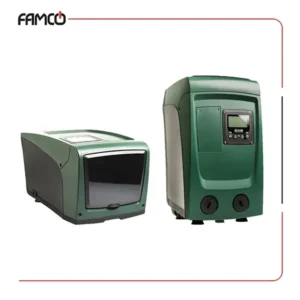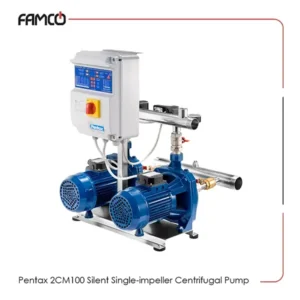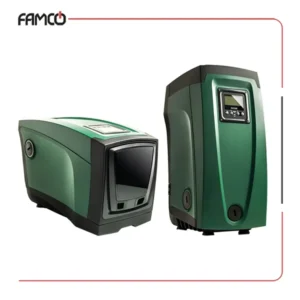Booster pumps are devices used to increase the pressure of liquid in a system, ensuring that it flows efficiently and reaches the desired locations.
Types of Booster Pumps
Here are some common types of booster pump:
Centrifugal Booster Pumps:
Single-Stage Centrifugal Pumps: These pumps have only one impeller and are suitable for low to moderate pressure increases.
Multi-Stage Centrifugal Pumps: These pumps have multiple impellers stacked together, allowing them to generate higher pressures. They are often used for more demanding applications.
Jet Booster Pumps:
Jet Pumps: These pumps use a jet of high-speed fluid (usually water) to create a vacuum, which then draws in and boosts the pressure of the main fluid. Jet pumps are commonly used for well water systems.
Diaphragm Booster Pumps:
Diaphragm Pumps: These pumps use a flexible diaphragm to displace the fluid. The diaphragm’s movement creates a pressure differential, boosting the liquid. They are often used for metering or dosing applications.
Peripheral Booster Pumps:
Peripheral Pumps: Also known as regenerative pumps, these have an impeller with many small blades around its periphery. The fluid is continuously accelerated by the impeller, providing high-pressure capabilities.
Submersible Booster Pumps:
Submersible Pumps: These pumps are designed to be submerged in the fluid they are pumping. Submersible booster pumps are often used in wells, boreholes, or other submerged applications.
Rotary Vane Booster Pumps:
Rotary Vane Pumps: These pumps use rotating vanes (blades) to move the fluid and increase pressure. They are commonly used for applications requiring continuous and smooth pumping.
Inline Booster Pumps:
Inline Pumps: These pumps are designed to be installed directly in the pipeline, providing a space-efficient solution. Inline booster pumps are often used in HVAC systems, water supply, or other applications where space is limited.
End Suction Booster Pumps:
End Suction Pumps: These pumps have a single suction impeller and are suitable for various applications, including boosting water pressure in buildings, irrigation, and industrial processes.
Vertical Multistage Booster Pumps:
Vertical Multistage Pumps: These pumps consist of multiple impellers arranged vertically. They are space-efficient and suitable for applications that require high pressure, such as water supply in tall buildings.
Booster Pump Price List
Several factors can influence the price of booster pumps. The cost of a booster pump can vary based on various considerations, including:
Type of Booster Pump:
Different types of booster pumps have varying complexities in their design and functionality, affecting their manufacturing costs. For example, a sophisticated multi-stage centrifugal booster pump may be more expensive than a simpler single-stage pump.
Capacity and Flow Rate:
The capacity and flow rate requirements of the booster pump play a significant role in determining its price. Higher capacity pumps with greater flow rates often come with higher price tags due to their larger and more powerful components.
Pressure Rating:
Booster pumps are designed to operate within specific pressure ranges. Pumps with higher pressure ratings typically cost more because they require more robust materials and construction to handle the increased forces.
Materials and Construction:
The materials used in the construction of the pump, such as stainless steel, cast iron, or other alloys, can impact the price. Corrosion-resistant materials or those suitable for specific applications may add to the overall cost.
Brand and Manufacturer:
Well-established and reputable brands in the pump industry may command higher prices due to their reputation for quality and reliability. Lesser-known or generic brands may offer lower-cost alternatives.
Energy Efficiency:
Energy-efficient booster pumps, designed to minimize power consumption, may have a higher initial cost but can result in lower operating costs over time. The energy efficiency rating and technology used in the pump can influence its price.
Control Features:
Advanced control features, such as variable speed drives, smart controls, and automation capabilities, can contribute to a higher price. These features may enhance the pump’s performance and efficiency.
Installation and Maintenance Requirements:
The complexity of installation and maintenance can affect the overall cost.
Pumps that are easy to install, operate, and maintain may be more attractive to buyers, impacting their price.
Application-Specific Requirements:
Booster pumps designed for specific applications, such as wastewater treatment, industrial processes, or residential water supply, may have additional features or specifications that influence their price.
Market Conditions:
Economic factors, market demand, and supply conditions can also impact the pricing of booster pumps. Fluctuations in material costs, labor expenses, or market trends can contribute to changes in pump prices.
How to Choose the Right Booster Pump for Your Needs
Choosing the right booster pump include High-Pressure Booster Pump for your needs involves considering several factors to ensure it meets the specific requirements of your application. Here’s a guide to help you make an informed decision:
Define Your Requirements:
Identify the specific needs of your application, including the required flow rate, pressure, and capacity. Understand the characteristics of the fluid you are pumping and any particular conditions that may affect the pump’s performance.
Determine the Type of Booster Pump:
Consider the different types of booster pumps available (e.g., centrifugal, jet, diaphragm) and choose the one that best suits your application. Factors such as pressure requirements, flow rate, and the nature of the fluid will influence this decision.
Calculate Total Dynamic Head (TDH):
Determine the total dynamic head, which is the sum of the elevation head, friction head, and pressure head. This calculation is crucial for sizing the pump correctly to overcome the resistance in the piping system.
Understand Pump Curve and System Curve:
Review the pump curve, which shows the relationship between flow rate and head, and compare it to the system curve, representing the hydraulic characteristics of your system. Select a pump whose curve intersects with the system curve at the desired operating point.
Consider Material Compatibility:
Ensure that the materials used in the pump construction are compatible with the fluid being pumped. This is crucial to prevent corrosion or damage over time. Consider factors such as temperature, pH, and chemical composition.
Evaluate Energy Efficiency:
Opt for an energy-efficient booster pump to minimize operating costs. Look for pumps with features like variable speed drives (VSD) that allow for better control and energy savings, especially in applications with varying demand.
Check Pressure and Flow Controls:
Verify that the booster pump has suitable pressure and flow control features. Depending on your application, you may need a pump with adjustable settings to match varying demand or maintain consistent pressure.
Assess Installation and Maintenance Requirements:
Consider the ease of installation and maintenance. Some pumps may require specialized knowledge or tools for installation and regular upkeep. Choose a pump that aligns with your maintenance capabilities and schedule.
Research Brands and Reviews:
Explore reputable brands with a history of reliability. Read customer reviews and testimonials to gain insights into the performance and durability of specific booster pumps.
Factor in Future Expansion:
Anticipate future needs and potential changes in demand. Select a booster pump that can accommodate potential growth or modifications in your system without requiring a complete overhaul.
Budget Considerations:
Establish a budget and compare the features and specifications of booster pumps within that budget range. Keep in mind that initial costs should be balanced with long-term operating costs and the overall value the pump provides.
Consult with Experts:
If you have uncertainties or complex requirements, consult with pump specialists or engineers who can provide guidance based on their expertise and experience.

